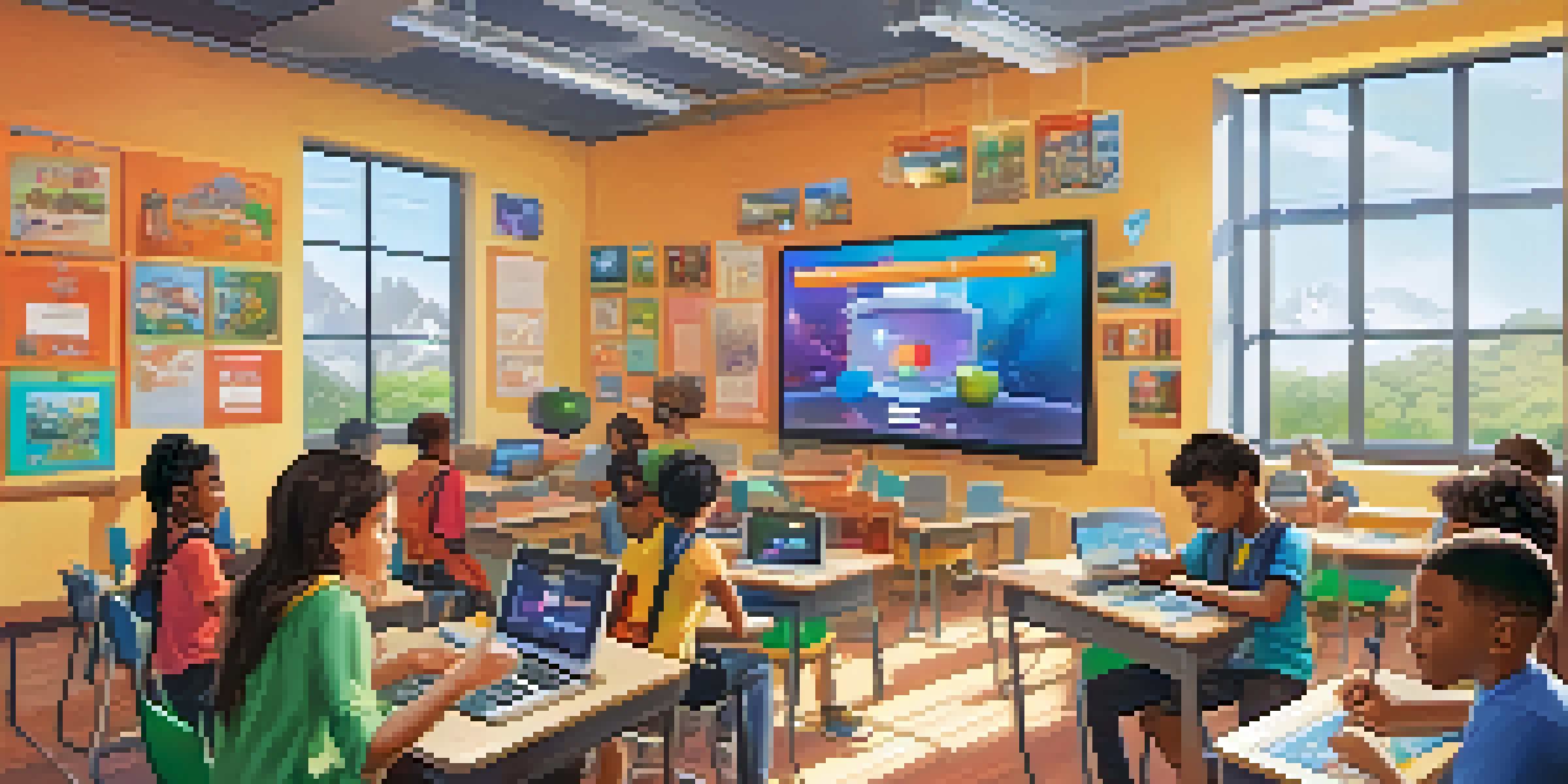Using Video Games as a Tool for Transmedia Learning

Understanding Transmedia Learning in Education
Transmedia learning is an educational approach that uses multiple media platforms to enhance learning. By integrating various formats like text, video, and, of course, video games, educators can create a richer learning experience. This method encourages students to engage with content across different mediums, reinforcing knowledge through diverse perspectives.
Education is not the filling of a pail, but the lighting of a fire.
Think of transmedia learning like a treasure hunt where each clue is hidden in a different format. For example, students might explore historical events through a documentary, then dive deeper by playing a video game set in that era. This interconnectedness helps learners see the bigger picture and understand concepts more thoroughly.
Ultimately, transmedia learning caters to different learning styles, making it an inclusive method. It allows visual learners to thrive with graphics and videos, while kinesthetic learners can benefit from interactive games. The goal is to create a holistic educational experience that resonates with all students.
How Video Games Enhance Learning Experiences
Video games captivate players through storytelling, interactivity, and challenges. These elements can be harnessed to promote critical thinking and problem-solving skills in educational settings. For instance, games that require strategic planning can teach students to think ahead and consider the consequences of their actions.

Additionally, video games often incorporate immediate feedback, which is essential for learning. Players can see the results of their decisions right away, allowing them to adjust their strategies in real time. This instant feedback loop encourages a growth mindset, where learners feel empowered to experiment and improve.
Transmedia Learning Enhances Education
Utilizing various media formats like video games and documentaries fosters a richer, more inclusive learning experience.
Moreover, the immersive nature of video games creates an engaging environment that keeps students motivated. When learners are emotionally invested in the game, they are more likely to grasp complex concepts and retain information. This level of engagement sets video games apart from traditional educational tools.
Examples of Educational Video Games in Use
Several video games have successfully merged entertainment with education. Games like 'Minecraft: Education Edition' allow students to explore subjects like math and science through creative building projects. By constructing environments, students can visualize and apply theoretical concepts in a tangible way.
Games aren’t just a way to pass the time; they can be a powerful educational tool that fosters engagement and critical thinking.
Another example is 'Civilization VI', which teaches players about history, geography, and diplomacy through gameplay. Players must navigate challenges and make decisions that affect the progression of their civilizations, mirroring real-world historical complexities. This not only makes learning fun but also encourages critical analysis of historical events.
These examples highlight how video games can serve as powerful educational tools. They engage students in a way that traditional methods often cannot, making learning more enjoyable and effective. By incorporating educational games into the curriculum, teachers can foster an environment where exploration and curiosity thrive.
The Role of Storytelling in Video Games
Storytelling is a fundamental aspect of many video games, and it plays a crucial role in transmedia learning. A well-crafted narrative can draw players in, making them emotionally invested in the characters and events. This connection enhances the learning experience as students explore themes and moral dilemmas within the game.
For instance, games like 'The Last of Us' present complex character arcs and ethical questions that prompt players to reflect on real-world issues. By navigating these narratives, students can develop empathy and a deeper understanding of social dynamics. This emotional engagement can lead to meaningful discussions in the classroom.
Video Games Boost Engagement
The interactive and immersive nature of video games keeps students motivated and enhances their understanding of complex concepts.
Additionally, storytelling in video games can help reinforce historical or scientific concepts. When students experience events through the eyes of a character, they gain a unique perspective that traditional textbooks may lack. This immersive storytelling encourages critical thinking and helps students make connections between the game and real-life scenarios.
Incorporating Video Games into the Curriculum
Integrating video games into the curriculum requires thoughtful planning and alignment with educational goals. Teachers can start by selecting games that complement existing lesson plans and enhance learning objectives. By doing so, educators can create a seamless blend of traditional teaching methods and interactive gameplay.
Moreover, it's essential to provide context for the games being used. Educators should clarify how the game relates to the subject matter and what specific skills or knowledge students are expected to gain. This helps students understand the purpose behind the gameplay and keeps them focused on learning outcomes.
Finally, teachers should encourage reflection after gameplay sessions. Discussing what students learned and how they applied their skills during the game can reinforce key concepts. This reflection not only solidifies knowledge but also allows students to share their experiences and insights, fostering a collaborative learning environment.
Challenges and Considerations for Educators
While video games offer unique learning opportunities, there are challenges to consider. One significant concern is ensuring that the games selected are age-appropriate and align with educational standards. Not every game is suitable for classroom use, so educators must be discerning in their choices.
Additionally, the potential for distraction is a valid concern. Students may become more focused on the gaming aspect rather than the educational content. To mitigate this, teachers should establish clear guidelines and objectives for gameplay, ensuring that students remain engaged with the learning material.
Storytelling Deepens Learning
Engaging narratives in video games encourage empathy and critical thinking, allowing students to connect with real-world issues.
Finally, not all educators may feel comfortable integrating video games into their teaching. Professional development and training can help teachers understand how to effectively use video games as educational tools. By fostering a positive attitude towards gaming in education, schools can create an environment where innovative learning methods thrive.
Future Trends in Video Games and Education
As technology continues to advance, the role of video games in education will likely expand. Virtual reality (VR) and augmented reality (AR) are already making waves, offering immersive experiences that can transport students to different times and places. Imagine studying ancient civilizations by walking through a virtual replica of a historic site!
Furthermore, the rise of gamification—applying game elements in non-game contexts—can enhance traditional learning methods. By incorporating points, badges, and leaderboards into lessons, educators can motivate students to engage more deeply with the material. This approach taps into the competitive and rewarding aspects of gaming.

In the coming years, we can expect to see more collaborations between game developers and educational institutions. This synergy could lead to the creation of tailored educational games that address specific learning needs and objectives. As these trends evolve, the potential for video games as transmedia learning tools will only grow stronger.